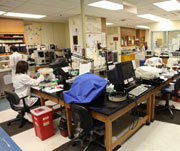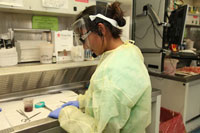Curriculum
Program Overview

Facilities:
The program uses the facilities of a large health care system that encompasses nine hospitals and offers numerous programs that benefit the communities that each institution serves. The Cooperman Barnabas Medical Center is a 600+ bed, tertiary care institution located in suburban Livingston. The department accessions and processes 25,000 surgical specimens, 10,000 cytology specimens, and 6 million clinical tests per year. The Newark Beth Israel Medical Center, located in Newark, affords the trainee the opportunity to experience pathology practice in an urban environment. The Monmouth Medical Center is located in Long Branch and offers a mix of urban and suburban practice. Overall, the facilities offer the opportunity for training that covers many aspects of pathology practice.
Program Structure:
The training period is 48 months leading to eligibility to sit for the certifying examination and subsequent certification in Anatomic and Clinical Pathology. Rotations in both disciplines are blended through each of four years resulting in 24 months of Anatomic Pathology training, 18 months of Clinical Pathology training, 2 months of elective mandatory rotations in distinct subspecialties and three months of elective time. Core rotations are taken at designated sites. Anatomic Pathology rotations are done through each of the three institutions, while Clinical Pathology rotations are at designated locations within the main institutions.
Opportunities:
The program has vast resources in terms of study material due to its broad patient base. There is ample opportunity for grant-funded research and there are numerous ongoing projects that trainees can participate in. There is funding for residents to attend national meetings if they have research projects to present. There is available elective time that gives the resident the opportunity to further enhance their education in specific areas of interest.
Sample Grid of Rotations:
12 Months
| First Year in Program | Second Year in Program | Third Year in Program | Fourth Year in Program | |
| Jan | CBMC - AP | BI - AP | MMC- AP | Immuno - CBMC |
| Feb | ||||
| Mar | ||||
| Apr | MMC - AP |
Clin
Chem - CBMC |
Micro - CBMC |
Elect Research
/Supp |
| May | ||||
| Jun | ||||
| Jul | BI - AP | Heme - MMC | Elect EM - CBMC | Cytog - MMC |
| Aug | ||||
| Sep | Elect Cyto - SB | Coag - BI | ||
| Oct | Blood Bank - BI | CBMC - AP | ||
| Nov | ||||
| Dec |
* 2 weeks toxicology
2 weeks laboratory administration
Goals and Objectives

Goal:
It is the goal of the Integrated Residency Program in Pathology to graduate a pathologist who is fully capable of serving the community as an active and respected member, who is looked up to by peers and community members, not only as a laboratory scientist and physician but a respected and emulated citizen.
Objectives:
- The trainee has a responsibility to himself/herself to take full advantage of the educational resources available within the Health-Care System.
- The trainee is an integral part of the health care team and, as such, must strive to learn the didactic aspect of laboratory science and the mechanics of daily laboratory practice including but, not limited to interaction with technical and medical staff as well as administrative personnel.
- The trainee will mature in the field of laboratory medicine as he/she progresses through rotations following the instructions, goals and objectives delineated for each rotation.
- The trainee will be given progressive responsibility for assigned cases and must follow through until their conclusion.
- The trainee must be made aware of and explore opportunities in Laboratory Medicine beyond the limits of the Health Care System to include participation in state and national organizations.
- The trainee is obliged to attend and present multidisciplinary conferences promoting intra and interdepartmental interaction and strive for academic growth through publication in peer reviewed journals.
